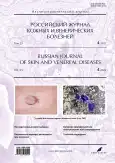Фотогалерея. Гнойный гидраденит (инверсные акне)
- Авторы: Теплюк Н.П.1, Пирогова А.С.1
-
Учреждения:
- Первый МГМУ им. И.М. Сеченова Минздрава России (Сеченовский Университет)
- Выпуск: Том 25, № 4 (2022)
- Страницы: 337-340
- Раздел: ФОТОГАЛЕРЕЯ
- URL: https://journals.rcsi.science/1560-9588/article/view/111836
- DOI: https://doi.org/10.17816/dv111836
- ID: 111836
Цитировать
Аннотация
Гнойный гидраденит (инверсные акне) ― хроническое воспалительное заболевание волосяного фолликула, патогенез которого включает фолликулярную окклюзию с последующим воспалением и разрушением придатков кожи, локализующихся в зонах, содержащих апокриновые потовые железы. Гнойный гидраденит клинически многолик и демонстрирует широкий спектр морфологических элементов сыпи на разных стадиях эволюции, различной локализации и степени тяжести. Для определения степени тяжести заболевания традиционно используется стадирование по Хёрли, где стадия I соответствует лёгкой форме заболевания, а стадии II и III ― средней и тяжёлой степени соответственно. Согласно классификации 2015 года Van Der Zee и Jemec, выделяется 6 фенотипов гнойного гидраденита: привычный тип, вариант по типу фрикционного фурункула, вариант по типу рубцующегося фолликулита, конглобатный тип, синдромальный тип, эктопический тип.
Предлагаем публикацию фотогалереи по данной проблеме.
Ключевые слова
Полный текст
Открыть статью на сайте журналаОб авторах
Наталия Павловна Теплюк
Первый МГМУ им. И.М. Сеченова Минздрава России (Сеченовский Университет)
Email: teplyukn@gmail.com
ORCID iD: 0000-0002-5800-4800
д.м.н., профессор
Россия, МоскваАнна Сергеевна Пирогова
Первый МГМУ им. И.М. Сеченова Минздрава России (Сеченовский Университет)
Автор, ответственный за переписку.
Email: annese@mail.ru
ORCID iD: 0000-0002-2246-1321
аспирант
Россия, МоскваСписок литературы
Дополнительные файлы


















